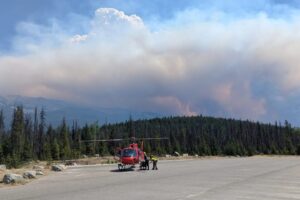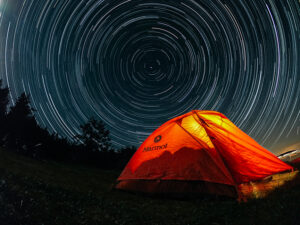I can count on one hand the number of times I’ve gone camping for the weekend. On the other hand, I’ve accumulated about four years in a tent in the Arctic, usually on six- to eight-week expeditions.
So admittedly for me, a tent is different than it is for most campers. When you live in something for weeks at a time, it has to be both secure and feel a little like home. Some extra weight is worth the roominess, for example, so you don’t feel like you’re crawling into a doghouse for two months.
Most of the time, I’ve used high-quality mountaineering dome tents, so I know their pros and cons well. Their head clearance is particularly good for tall people. Most are hexagonal-shaped, and the side corners are ideal real estate for personal gear. Because they’re freestanding, often you don’t need to stake them down like Gulliver by the Lilliputians.

Jonathan Swift’s Gulliver, well cinched-down.
Dome tents have one main disadvantage, and that is wind. Although they’re structurally stable when up, inserting the third and fourth poles, which give the dome its rigidity, is a wrestling match against forces that want to rip the half-finished tent from your hands and send it skirling away like a tumbleweed. Once started on such a trajectory, you will never, ever catch it.
Having to attach a separate fly doubles the time in which you are in real peril of losing your shelter or snapping a pole if a gust hits at the wrong time.

Setting up a dome tent in a gale as night falls during an early Labrador expedition. Partially sheltered but still difficult. Photo: Jerry Kobalenko
Chogori
Which is why I really appreciated the design of Nemo’s Chogori mountaineering tent. First, the inner tent and outer fly are permanently attached to one another, with an air space between them. No fussing with a separate fly.
Second, you can insert all four poles in such a way that the tent lies flat until you’re finished. No danger of blowing away during this most vulnerable time. Then you can quickly bend the poles into position, then clip the tent to them. In almost no time, the entire tent has its rigid structure. Now you can continue staking it down.
The Chogori feels like a modern version of a classic dome tent. It has all the advantages of a time-honored dome, but it’s been rethought through a contemporary lens. This has eliminated many of the disadvantages of its predecessors.
Features
Some of the tent’s many pros:
– Six interior mesh pockets, three on each side, plus two light pockets on the ceiling to diffuse the headlamp glow.
– Spacious. Some tents advertise themselves as being for three persons like freeze-dried meals cynically claim “Serves Two”. The Chogori 3P actually fits three comfortably, though I would use it for two on winter expeditions when clothes and sleeping bags are extremely bulky. The Chogori also comes in a slightly smaller and lighter two-person version, the Chogori 2P.
– Lightweight. New materials have reduced the overall weight to just under four kilos, almost a kilo lighter than comparably large tents.
– The fly incorporates a plastic window. This isn’t a new feature — my old dome has it too — but it’s a useful accessory. Typically, you won’t see a lot through it, especially in cold weather, because the humidity from breath frosts it over from the inside. But the diffuse light is noticeable. Incidentally, the great polar ship Fram used a similar idea. Thick crystal wedges embedded in the top deck let natural light into the staterooms below.
– Expedition tents like this one are made for colder weather and can get unbearably hot when the sun beats on them. The Chogori does its best to minimize this with zippers on the ceiling and a little pop-up chimney on the exterior fly to vent the warm air.


Inner tent and outer fly are permanently attached but still feature a dead air space between them. Photo: Jerry Kobalenko
The peculiar problem of cold
As someone who has often camped in temperatures closer to the cold of outer space than our typical cool winters can provide, I look at materials differently. At -15˚C, everything behaves pretty normally. At -40˚ or -50˚, they do not. The little plastic biners (there are five of them) that hold interlocking poles together depend on the flexibility of the plastic to detach the metal gate.
But in severe cold, most plastic loses its flexibility. Sometimes it breaks. Sometimes it just becomes rigid and immovable. Although you need to give these biners just a little squeeze to release the gate, I will add a couple of spare metal utility biners to my repair kit until I see how these plastic ones behave at -40˚.

Photo: Jerry Kobalenko
Winds and dome tents
I have not yet used the Chogori in high winds, but other good mountaineering domes are cozy to about 50kph. Then they start to whump! up and down, as if breathing convulsively, as the wind gets underneath the tent and shakes it. The Chogori‘s convenient snow apron keeps mild breezes from sneaking under the fly and cooling off the inner tent, but would not hold out a determined wind.
At even higher winds, these convulsions of a dome trying to shake itself free of its moorings become even more noticeable. At 75kph, I once had to line the inside of my dome with heavy rocks to keep the tent down.
So on expeditions likely to be very windy, I reluctantly leave my dome behind and use a tunnel tent instead. Tunnels are far superior in crazy winds. That’s why everyone uses them in Antarctica. They set up relatively easily in a gale, with no danger of blowing away. I’ve had a tunnel tent in winds up to 110kph, with no problem.
Drawbacks of tunnel tents
But tunnels have their own disadvantages. Because they aren’t freestanding, solid anchors are a must even in calm conditions. Such anchors can be hard to come by in certain environments, such as soft sandy beaches or the mushy snow of late spring.
Tunnels are narrower than domes and don’t have that corner real estate for personal gear stowage. With two big guys, only one can get into his bulky expedition sleeping bag at a time. There isn’t enough room for both to do it at once. More coordination and less independent movement is required.

Tunnel tent in a 75kph crosswind. No problem, if guyed down with 400kg of rocks. Photo: Jerry Kobalenko
The other disadvantage comes up in a snowy blizzard when the wind shifts to a crosswind. The tunnel can handle the crosswind itself, but drifting snow accumulates on the windward side of the tent. This doesn’t happen when the tent is oriented properly, nose or tail to the wind. But in crosswinds, the snow must be shoveled away every couple of hours, or it will engulf the tent completely.
My partner and I once had to dig for eight hours to excavate our tent and its many guylines after a two-day storm that turned the snow into concrete. On that occasion, we had originally gone to sleep in calm conditions and woke up with the storm upon us and no time to re-orient the tent.
No item of gear is perfect, no matter how excellent, which is why you need different designs for different situations. For those conditions allowing domes, the Chogori is now my go-to.
See Nemo Chogori 3P on Nemo Equipment

Camp Buried Alive, Ellesmere Island. Photo: Jerry Kobalenko






